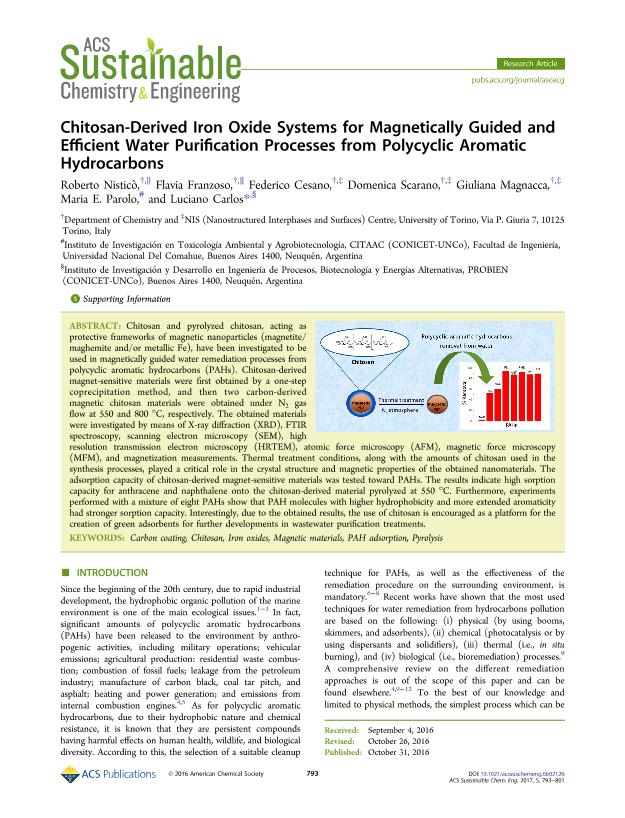Mostrar el registro sencillo del ítem
dc.contributor.author
Nisticò, Roberto
dc.contributor.author
Franzoso, Flavia
dc.contributor.author
Cesano, Federico
dc.contributor.author
Scarano Domenica
dc.contributor.author
Magnacca, Giuliana
dc.contributor.author
Parolo, Maria Eugenia

dc.contributor.author
Carlos, Luciano

dc.date.available
2018-11-27T21:14:49Z
dc.date.issued
2017-01
dc.identifier.citation
Nisticò, Roberto; Franzoso, Flavia; Cesano, Federico; Scarano Domenica; Magnacca, Giuliana; et al.; Chitosan-Derived Iron Oxide Systems for Magnetically Guided and Efficient Water Purification Processes from Polycyclic Aromatic Hydrocarbons; American Chemical Society; ACS Sustainable Chemistry and Engineering; 5; 1; 1-2017; 793-801
dc.identifier.issn
2168-0485
dc.identifier.uri
http://hdl.handle.net/11336/65388
dc.description.abstract
Chitosan and pyrolyzed chitosan, acting as protective frameworks of magnetic nanoparticles (magnetite/maghemite and/or metallic Fe), have been investigated to be used in magnetically guided water remediation processes from polycyclic aromatic hydrocarbons (PAHs). Chitosan-derived magnet-sensitive materials were first obtained by a one-step coprecipitation method, and then two carbon-derived magnetic chitosan materials were obtained under N2 gas flow at 550 and 800 °C, respectively. The obtained materials were investigated by means of X-ray diffraction (XRD), FTIR spectroscopy, scanning electron microscopy (SEM), high resolution transmission electron microscopy (HRTEM), atomic force microscopy (AFM), magnetic force microscopy (MFM), and magnetization measurements. Thermal treatment conditions, along with the amounts of chitosan used in the synthesis processes, played a critical role in the crystal structure and magnetic properties of the obtained nanomaterials. The adsorption capacity of chitosan-derived magnet-sensitive materials was tested toward PAHs. The results indicate high sorption capacity for anthracene and naphthalene onto the chitosan-derived material pyrolyzed at 550 °C. Furthermore, experiments performed with a mixture of eight PAHs show that PAH molecules with higher hydrophobicity and more extended aromaticity had stronger sorption capacity. Interestingly, due to the obtained results, the use of chitosan is encouraged as a platform for the creation of green adsorbents for further developments in wastewater purification treatments.
dc.format
application/pdf
dc.language.iso
eng
dc.publisher
American Chemical Society

dc.rights
info:eu-repo/semantics/openAccess
dc.rights.uri
https://creativecommons.org/licenses/by-nc-sa/2.5/ar/
dc.subject
CARBON COATING
dc.subject
CHITOSAN
dc.subject
IRON OXIDES
dc.subject
MAGNETIC MATERIALS
dc.subject
PAH ADSORPTION
dc.subject
PYROLYSIS
dc.subject.classification
Otras Ciencias Químicas

dc.subject.classification
Ciencias Químicas

dc.subject.classification
CIENCIAS NATURALES Y EXACTAS

dc.title
Chitosan-Derived Iron Oxide Systems for Magnetically Guided and Efficient Water Purification Processes from Polycyclic Aromatic Hydrocarbons
dc.type
info:eu-repo/semantics/article
dc.type
info:ar-repo/semantics/artículo
dc.type
info:eu-repo/semantics/publishedVersion
dc.date.updated
2018-11-20T15:15:36Z
dc.journal.volume
5
dc.journal.number
1
dc.journal.pagination
793-801
dc.journal.pais
Estados Unidos

dc.description.fil
Fil: Nisticò, Roberto. Università di Torino; Italia
dc.description.fil
Fil: Franzoso, Flavia. Università di Torino; Italia
dc.description.fil
Fil: Cesano, Federico. Università di Torino; Italia
dc.description.fil
Fil: Scarano Domenica. Università di Torino; Italia
dc.description.fil
Fil: Magnacca, Giuliana. Università di Torino; Italia
dc.description.fil
Fil: Parolo, Maria Eugenia. Universidad Nacional del Comahue; Argentina
dc.description.fil
Fil: Carlos, Luciano. Consejo Nacional de Investigaciones Científicas y Técnicas. Centro Científico Tecnológico Conicet - Patagonia Norte. Instituto de Investigación y Desarrollo en Ingeniería de Procesos, Biotecnología y Energías Alternativas. Universidad Nacional del Comahue. Instituto de Investigación y Desarrollo en Ingeniería de Procesos, Biotecnología y Energías Alternativas; Argentina
dc.journal.title
ACS Sustainable Chemistry and Engineering
dc.relation.alternativeid
info:eu-repo/semantics/altIdentifier/url/https://pubs.acs.org/doi/abs/10.1021/acssuschemeng.6b02126
dc.relation.alternativeid
info:eu-repo/semantics/altIdentifier/doi/http://dx.doi.org/10.1021/acssuschemeng.6b02126
Archivos asociados
